Baking stones: what are they, how to choose and care for them?
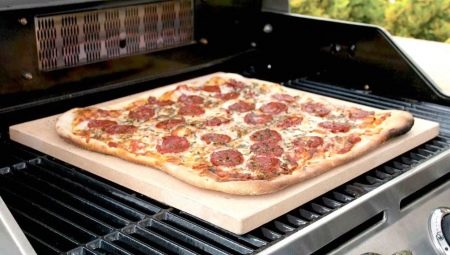
The baking stone is a very useful invention and is widely used for baking various dishes. Despite the fact that the technology of cooking with its help is only gaining popularity, the stone has already gained a sufficient number of fans around the world, including in our country.
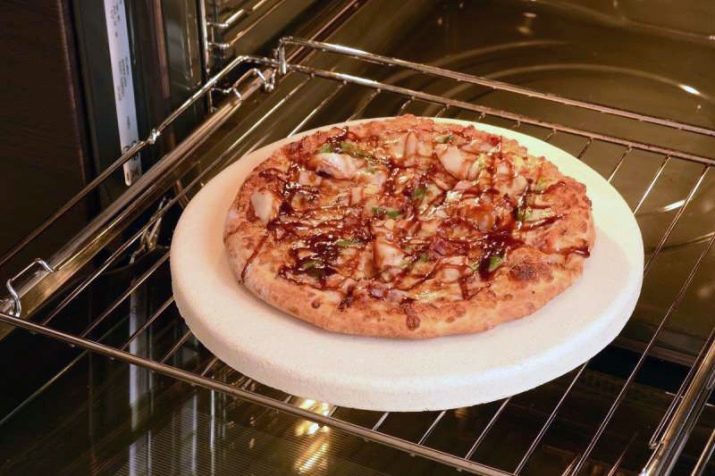
What it is?
Baking stones represent solid or stacked plates used for baking bread and other products at home. Baking, for the manufacture of which a baking stone is used, in its taste becomes as close as possible to dishes from a tandoor or a Russian oven.
The secret of such success is quite simple and consists in the following: A stone heated to a high temperature from the first seconds heats the yeast dough to its full thickness, as a result of which the bread has time to rise as much as possible before a crust forms on top.
The dough with this technology does not crack, which is explained by the death of the yeast at +60 degrees and the ability of the stone to maintain a given temperature until a crust forms.... As a result, the bread does not break and is perfectly smooth and baked. Even the cuts on the loaves only open slightly and do not break.
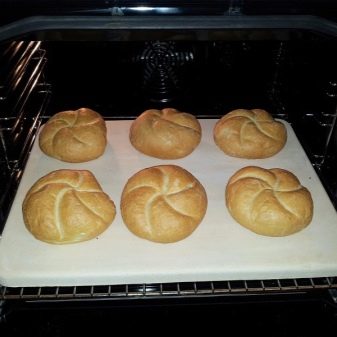
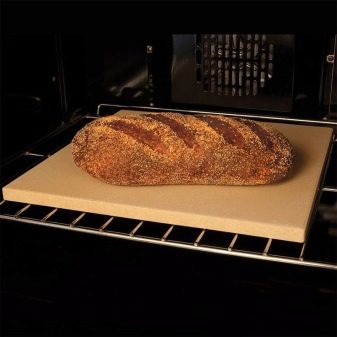
Baking plates can be made v circle, square and rectangle shape... Round ones are mainly used for making pizza, while the last two options are universal and suitable for baking any kind of dish.
The thickness of the products varies from 1.5 to 3 cm, which depends on the manufacturer and the material of manufacture.For example, Chinese models often have a lower cost, but they are too thin and quickly crack. There are stones that are thicker than 3 cm, but their use is not very rational in terms of electricity or gas consumption.
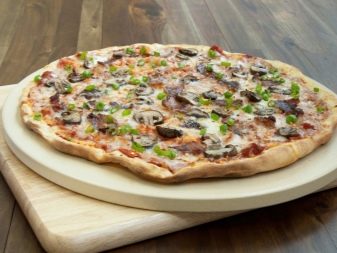
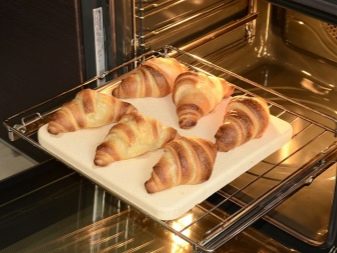
Thick specimens require a longer warm-up period, which averages 30 minutes for every 1 cm of thickness. The optimal thickness is 2-2.5 cm. Such models quickly warm up and give off their heat for a long time.
The sizes of stones are also very diverse, but the most convenient dimensions are 30x45 cm. If the size of the oven allows, then such products are considered the most optimal option and allow you to simultaneously bake three baguettes and two oblong loaves of bread. As for the design, one-piece models are somewhat more expensive than type-setting options.
The latter usually represent several tiles with a ribbed bottom surface with a thickness of 1.5 to 2 cm. Their disadvantage is excessive fragility, and the advantages include low cost and the ability to use in small ovens.

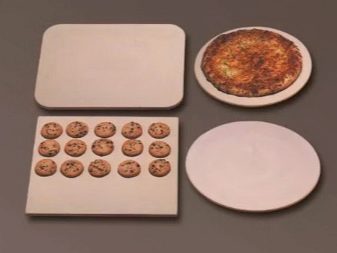
The steadily growing consumer demand for baking stones is due to such undeniable advantages as the possibility of baking without the use of oil, uniform baking of the dough, complete environmental friendliness of the process and the formation of a crispy appetizing crust.
The latter can be achieved due to the property of the stone to absorb moisture from the dough, giving off a large amount of heat in return. The environmental friendliness of the use of models is due to the presence in the composition of the stone exclusively natural componentsthat do not enter into dangerous chemical reactions with food, as is the case when frying in a pan with oils.

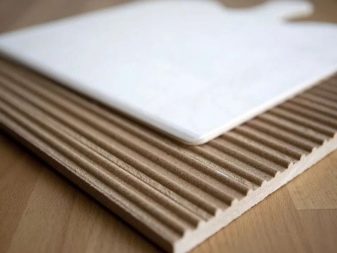
In addition, when the oven is preheated, the stone becomes very hot, which leads to the effect of a hearth oven inside the oven. As a result, the baking time is significantly reduced and the baking turns out to be fluffy, airy and very fragrant... The advantages include ease of use and easy maintenance. Products do not require the use of cleaning agents, can be washed perfectly with warm water and a clean cloth, and can also be placed in the dishwasher.
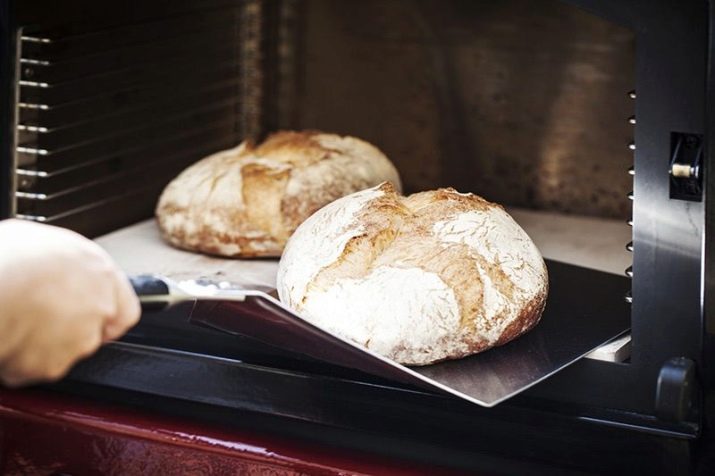
Moreover, most baking stones are very strong and have a compressive strength of 50 MPa, which corresponds to 50 kg weight per cm². Models perfectly withstand temperatures up to +1500 degrees and are not afraid of its drops.
What is it needed for?
The baking stone is a real salvation for housewives who use ovens with uneven heating. In such ovens, one side of the baked goods is often burnt, while the other remains practically soggy. Due to the presence of microscopic pores, a hot stone is able to maintain the required temperature inside the oven for a long time without leading to its rise.
As a result, the dough is baked very evenly, the bottom does not burn, and a ruddy crust forms on top. Moreover, the models are able not only to maintain a certain temperature, but also to equalize it in different parts of the oven. The baking stone is perfect for the production of brown bread, pizza, muffins, flatbreads, lavash and baguettes, as well as for baking meat, fish and potatoes.
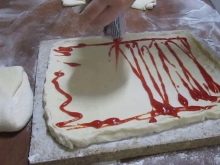
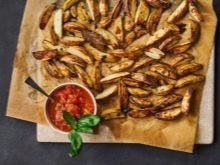
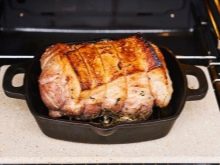
What materials is the stone made of?
Clay and natural minerals are used as materials for the manufacture of baking plates.
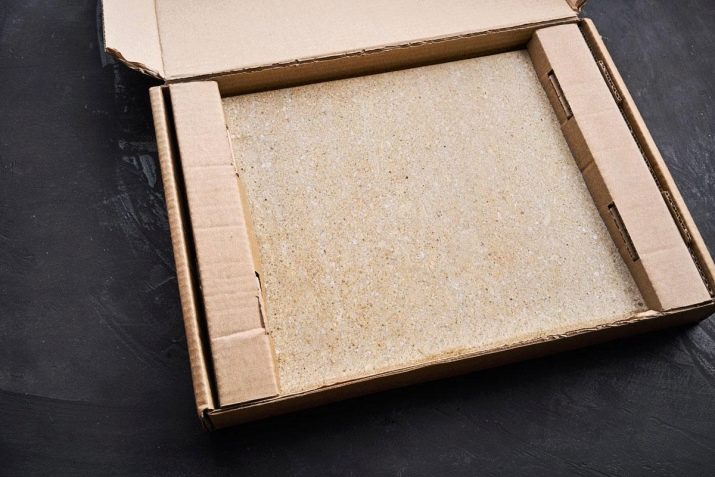
Clay
Clay stones or slabs have more porous structure in comparison with natural stone and absorbs moisture much better. The products are absolutely safe for human health, which is due to the absence of toxic impurities and toxic components in their composition. Clay does not react with food, guaranteeing absolute naturalness and purity of baked dishes.
The only drawback is not too high resistance to temperature changes, due to which the service life of clay specimens is much inferior to the service life of models made of natural stone. Clay slabs can be glazed or not.
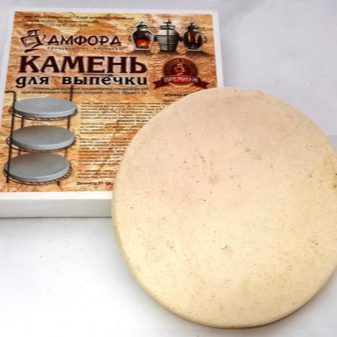
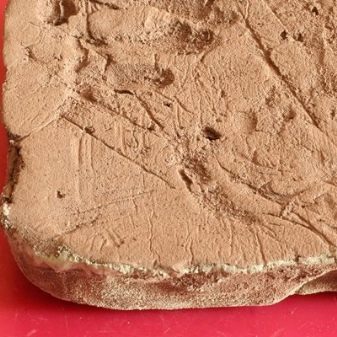
Their surface is usually even, but recently products with a raised bottom have begun to appear, contributing to the improvement of the circulation of hot streams. There are models with imitation of small stones, on which it is especially convenient to bake bread.
For the manufacture of baking plates, two types of clay are used.
- Red... It is distinguished by its low price, low weight and very fast heating. The disadvantages of red clay products include fragility and a high probability of splitting when cold water hits a hot surface. In this regard, it is not recommended to spray the confectionery when using ceramic models.
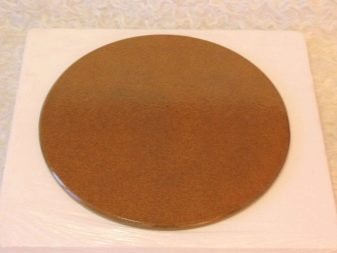
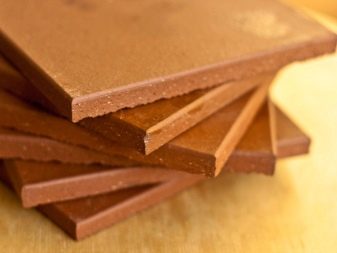
- Shamotnaya... Products made from chamotte types of clay, are characterized by high strength and long service life. These stones are often made by hand, which ultimately increases their value. Stamped prefabricated plates are much cheaper and are characterized by lighter shades. Moreover, with constant use, the clay darkens noticeably, which is a natural process and in no way affects the quality of food and the durability of products.
The only drawback of fireclay models is lower porosity, which can adversely affect the quality of yeast baked goods and bread.
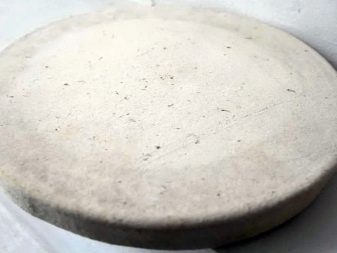
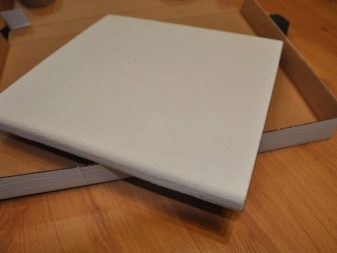
A natural stone
Refractory minerals such as sandstone and quartzite... They are distinguished by high porosity and are able to quickly accumulate and give off heat for a very long time. In addition, sandstone is a very durable stone and tolerates cooling and heating well. Models made of this mineral usually have a thickness of 1 cm and more, are characterized by a wide palette of shades, including white, fawn and green with gray streaks.
Indian quartzite is a "relative" of sandstone, but in terms of its density and durability it is much superior to it. Both materials completely harmless and do not emit any foreign smell and harmful substances when heated. The disadvantages of both materials include high cost products made from them, which is due to the difficulties of transportation and processing of minerals.

However, models of smoother and harder minerals are often found - granite, marble and steatitethat have both undoubted advantages and significant disadvantages. So, marble stones have a very attractive appearance and have the right number of pores, but they do not tolerate temperature changes very well and are expensive.
Granite stones keep heat for a very long time, but due to their volcanic origin, they can release a small amount of harmful substances when heated. However, their concentration is not so critical, many professional bakers use stones exclusively from this mineral. Steatite or soapstone tends to heat up very quickly and give off heat very slowly, but has a very dense structure, weighs quite a lot and has no pores.

Natural materials are very durable, they tolerate high temperatures and high humidity well. However, many of them can turn out to be toxic or change the taste of baked baked goods, therefore, independent selection of a stone for the oven is prohibited, you should use only minerals permitted for use.
Manufacturers overview
The modern market for kitchen accessories offers a wide range of baking stones. Among the manufacturers there are both small, little-known companies and large firms that have an excellent reputation and provide consumers with durable and high-quality products. These include LLC "Pekarsky Kamen" from St. Petersburg, producing models under the brand name "Gourmet".
The products of the enterprise are distinguished by high working qualities and reasonable prices. For example, the most budget model made of volcanic rock can be purchased for only 1,650 rubles. The product is produced in dimensions 38x28x1 cm and weighs 2.4 kg.

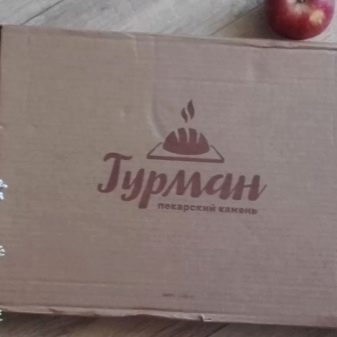
Due to its compact size, the stone is perfect for conventional stoves with ovens powered by gas or electricity. You can cook anything on the Gourmet stones, from buns and pies to stuffed vegetables and meat dishes.
An equally well-known manufacturer is the company Weber, which produces round and rectangular baking stones. Among the assortment, one can note a round model designed for making pizza and costing 4999 rubles. The product is equipped with comfortable grips and a non-stick coatingallowing you to cook with little or no oil.
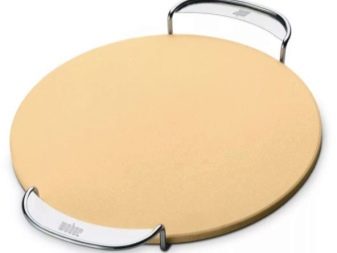
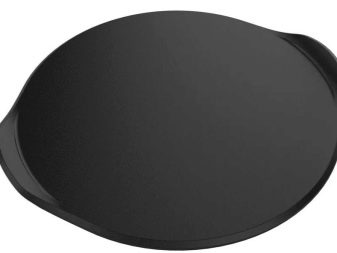
How to choose?
When choosing a baking plate, first of all, you should focus on its thickness. For non-professional use, it is better to buy a product with a thickness of 1.5-2 cm, which will allow you to bake bakery products on it, as well as to cook meat, fish and other dishes.
If the stone is purchased exclusively for pizza, then you can opt for a round model, but if you intend to use it for cooking various dishes, then it is more rational to purchase a rectangular version. As for the size of the stone, then its dimensions should be 3-4 cm less than the inner area of the oven. This will provide adequate wall clearance and promote proper circulation of hot air.
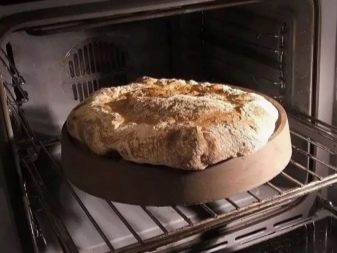
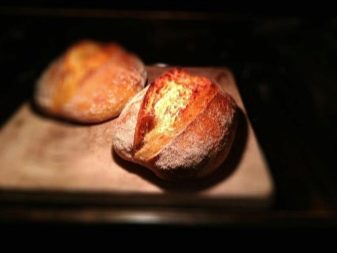
An important criterion for choosing a baking oven is its porosity... So, if a model is purchased for baking bread and muffins, then it is desirable that it have a more porous surface, but sweet pastries, cheesecakes and meat rolls can be baked on denser specimens. For making pizza, it is better to choose a product with a thickness of 1-1.5 cm, which will contribute to faster heating of the material and significantly reduce the cooking time.
In addition to pizza, lavash, khachapuri and products made from unleavened or puff pastry can be baked on thin plates. When choosing a baking stone, you should know that more durable are models equipped with angular or longitudinal legs. The presence of an air gap between the baking sheet and the baking plate eliminates thermal shock of the material, which significantly extends the service life of the product.
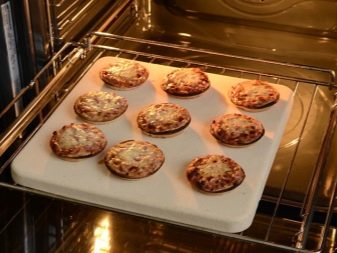
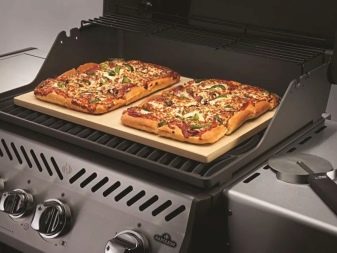
In addition, before purchasing, you must familiarize yourself with the certificate of conformity confirming the purity of raw materials and the absence of harmful impurities in the composition of the stone.
Operation and care
In order for a baking plate to last for a very long time, a number of simple rules must be followed.
- Before you start using a new stone, you need to put it in the oven and ignite it at +250 degrees. The calcining time depends on the thickness of the model, on average it is 30 minutes. /cm. After the stone is calcined, the oven should be turned off and opened, allowing the mineral to cool naturally.
- The stone should be used "dry", it is not recommended to process it with vegetable oil. Otherwise, the oil film will tighten the pores, and heat transfer may be impaired. If necessary, the surface of the stone can be covered with flour or covered with parchment paper, and meat and fish can be cooked wrapped in foil.
- In no case should the stones be exposed to sudden temperature changes, taking it out of the stove and placing it under a stream of cold water. The product must cool down gradually, otherwise it will become brittle and crack quickly. The same applies to its heating: in no case should a cold stone be placed in an already preheated oven. It should only heat up and cool down together with the oven. In addition, a damp stone should not be placed in a preheated oven.
- Between the baking plate and the bottom of the oven there must be an air gap, so you should not put the product on the bottom. If necessary, place it on the wire rack and position it as low as possible.
- For laying out bread pieces it is necessary to use a special shovel, which often comes with the stone.
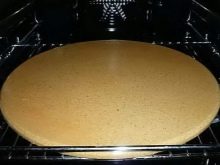

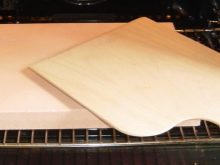
As for the care of the baking stove, it includes regular rubbing of clay products with a damp cloth and washing natural stone models in warm water. It is prohibited to clean the models using household chemicals. For stubborn dirt, use a soft brush.
For information on how to use a baking stone correctly, see the next video.








